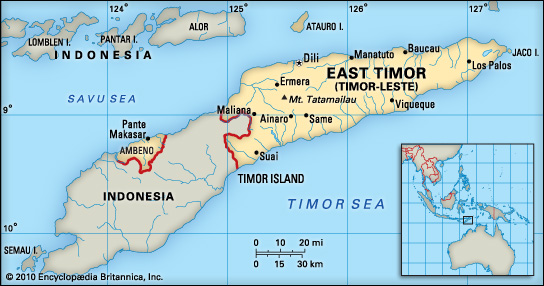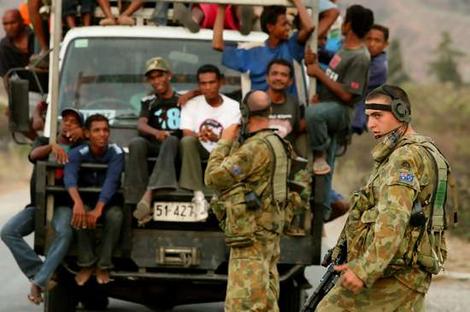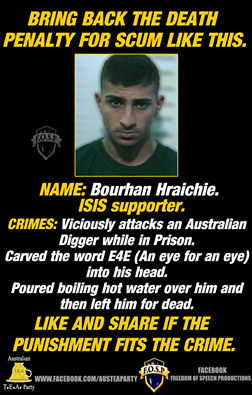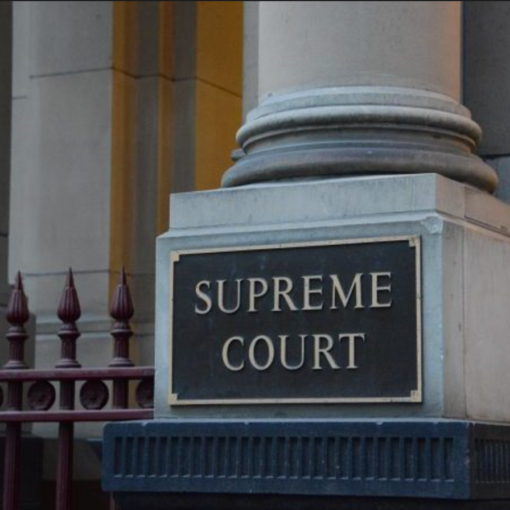
In a Nutshell
When the Portuguese Empire collapsed in 1975 and they pulled out of East Timor—President Suharto of Indonesia moved in. At the time of the invasion about 45% of the East Timor was Catholic, the rest practiced a version of animism. It was NEVER islamic. That year East Timor was officially declared the 27th province of Indonesia.
However, the island resisted Indonesia’s occupation which resulted in 200,000 of the 700,000 population being starved and slaughtered by their Islamic militia. Interestingly, conversions to Christianity increased to 90% of the population as a backlash to the Islamic brutality.
in 1998 the Asian Economic Collapse brought about a change of Government within Indonesia and Suharto resigned. In an effort to stop the $1 million dollar a day cost of the East Timor invasion the new President Habibie offered East Timorese a referendum to determine their position of Autonomy within Indonesia or complete independence. Despite horrific intimidation by the Islamic occupying forces up to the election, East Timorese voted for complete Independence.
The occupying militias became violent as expected. The UN called in Australia as part of the 22 nation UN Peace Keeping force to enforce East Timor’s decision. It took three years before order was finally restored, and East Timor took its place at the United Nations table.
Australian currently allocates $85 million foreign aid PA to support the peace of the now 95% Christian East Timor. (Islam .3% )
East Timor never was a Muslim nation. It remained fiercely independent and Christian even during its 23 year occupation by Indonesian Islamic forces.
The Shocking Occupation of East Timor by Indonesia
East Timor is the eastern end of Timor Island, part of the vast archipelago that today makes up the island state of Indonesia. Originally a Portuguese colony, — it was one of the famous “spice islands” — it became a tempting morsel for the military government of neighbouring Indonesia when the Portuguese empire collapsed in a bloodless military coup in 1975. Indonesia did not have any valid claim to it, but President Gerald Ford and Secretary of State Henry Kissinger, who were visiting Jakarta, nevertheless approved the Indonesian invasion of the former Portuguese on December 7, 1975. They only asked that the attack be delayed until after their departure.
Kissinger told reporters that “the United States understands Indonesia’s position on the question of East Timor” and the U.S. abstained in the subsequent U.N. vote condemning the invasion. As then-US Ambassador to the UN Daniel Patrick Moynihan said, “The United States wished things to turn out as they did, and worked to bring this about. The Department of State desired that the United Nations prove utterly ineffective in whatever measures it undertook. This task was given to me, and I carried it forward with no inconsiderable success.” Suharto was delighted to have received U.S. support for the invasion because of the Indonesian army’s reliance on American weaponry that, by U.S. law, could only be used for defensive purposes.
Independence for East Timor, or even limited regional autonomy, was never going to be allowed under Suharto’s New Order.

The East Timorese did not want to be forcibly incorporated into Indonesia, and an insurgency ensued. Washington continued to supply arms to Indonesia that were obviously not meant for general defence purposes, but specifically chosen to meet the needs of a counterinsurgency campaign.
Ultra-conservative Muslims rallied to the president’s side, calling for jihad against independence fighters in East Timor, now portrayed not merely as anti-Indonesian but anti-Islamic.
President Suharto’s carnage was on a scale worthy of Pol Pot. By 1989, Amnesty International estimated that Indonesia had murdered 200,000 East Timorese out of a population of 600,000-700,000.
(Indonesia’s treatment of religious minorities had already been tested in West Papua. Suharto’s anticommunist credentials enabled him to preserve the support of the U.S. government while he terrorized the inhabitants of Dutch New Guinea, which was handed over to Indonesia in 1962 and its name changed to Irian Jaya, Victorious Irian. The tribal people of West Papua had nothing in common with Indonesia, except that both had previously been ruled by Holland. They are Melanesians and not Indo-Malays, and Christians or animists. Indonesia is an ethnically-diverse nation – frankly, an object lesson in the follies of multiculturalism — consisting of a dominant and expansionist over-populated Javanese core that holds onto its other territories by force.)
Under Suharto the army rounded up all the children from the Christian missions and forced them to attend state Islamic schools. Passive resistance to Indonesian control was widespread and zealous Muslim officers responded by ordering soldiers to kill the villagers’ pigs, an important element in their basic economy. They soon proceeded to killing people: by September 1973, over 30,000 civilians had been killed by Indonesian troops, the number rising to an estimated 100,000 by 1990.
In the motivation patterns and perceptions of the actors on the ground, killers and victims alike, East Timor was an Islamic jihad against Christian infidels, identical in form and purpose to other tragedies caused by Islam’s insatiable appetite for other people’s lands, property, bodies, and souls.
Dili’s bishop, Mgr. Coste Lopez, later stated: “The soldiers who landed started killing everyone they could find. There were many dead bodies in the streets.” They had been told that they were fighting a jihad and whole villages, for example Remexio and Aileu, were slaughtered.
In Dili hundreds of the ethnic Chinese minority were shot and thrown off the wharf into the sea. In Maubara and Luiquica, the entire Chinese populations were wiped out. Nineteen ships were moored in Dili harbour to remove looted cars, radios, furniture, tractors and whatever else could be ransacked. Chinese population was exterminated and the women (and girls) were kept on board Indonesian ships to serve as sex slaves. Designated as “right hand” possessions these women and girls serviced Muslims in the Indonesian military who were sent to East Timor. These same military personnel profited handsomely from the material thefts as they caroused in their brothels of sex slaves. History books make no mention of the role of the imams in Jakarta who encouraged this kind of behaviour within military ranks.
Churches and the seminary were looted and their books burnt. Many priests had moved to the hills, with their flocks and were able to report on the massacres of children in Lospalos, Viqueque, Amoro and Sumalai. Priests were beaten, churches invaded and their congregations arrested.

By November 1976, the death toll had reached 100,000. The military focused on the more educated strata of Timorese seminarians, teachers, nurses and public officials.
Australian Consul to East Timor, James Dunn, reported that East Timorese refugees were not even safe in West Timor: two thousand men, women and children had been burnt or shot to death at Lamaknan. At the concentration camp on Atauro island, the prisoners were given one small can of corn per person per week. They had to supplement this with leaves, roots or whatever else they could find. Punishment for listening to foreign broadcasts or speaking in Portuguese included beatings, burning with cigarettes on face and genitals, electric shock, water immersion and the removal of toe nails.
It was the Imams in Jakarta who encouraged this kind of behavior within military ranks. Many historians ignored the central importance of Islam in order to explain the depravity of the Indonesian military and how Islamic clergy influenced and financed proselytization of Islam in east Timor during those occupation years.
However with the Asian collapse and Suharto subsequent retirement the new President Habibie announced that Indonesia would soon offer East Timor a special plan for autonomy. The insurgency in East Timor was costing the bankrupt indonesian Government a million dollars a day.
In late 1998, the Australian Government of John Howard drafted a letter to Indonesia advising of a change in Australian policy, and advocating a referendum on independence within a decade. President Habibie saw such an arrangement as implying “colonial rule” by Indonesia and he decided to call a snap referendum on the issue.[7]
Indonesia and Portugal announced on 5 May 1999 that a vote would be held allowing the people of East Timor to choose between the autonomy plan or independence. The vote, to be administered by the United Nations Mission in East Timor (UNAMET), was originally scheduled for 8 August but later postponed until 30 August. Indonesia also took responsibility for security; this arrangement caused worry in East Timor, but many observers believe that Indonesia would have refused to allow foreign peacekeepersduring the vote.
As groups supporting autonomy and independence began campaigning, a series of pro-integration paramilitary groups of East Timorese began threatening violence—and indeed committing violence—around the country. As militia leaders warned of a “bloodbath”, Indonesian “roving ambassador” Francisco Lopes da Cruz declared: “If people reject autonomy there is the possibility blood will flow in East Timor.
The day of the vote, 30 August 1999, was generally calm and orderly. 98.6 percent of registered voters cast ballots, and on 4 September UN Secretary-General Kofi Annan announced that 78.5 percent of the votes had been cast for independence.[14]
Indonesians were either shocked by, or disbelieved that the East Timorese had voted against being part of Indonesia. Many accepted media stories blaming the supervising United Nations and Australia who had pressured Habibie for a resolution.[15]
Within hours of the results, Muslim paramilitary groups had begun attacking Timorese people and setting fires around the capital Dili. Foreign journalists and election observers fled, and tens of thousands of East Timorese took to the mountains. Islamic gangs attacked Dili’s Catholic Diocese building, killing two dozen people; the next day, the headquarters of the ICRC was attacked and burned to the ground. Almost one hundred people were killed later in Suai, and reports of similar massacres poured in from around East Timor.[16] The vast majority of the UN staff locked down in their Dili compound, which had been flooded with refugees, refused to evacuate unless the refugees were withdrawn as well, insisting they would rather die at the hands of the paramilitary groups.[14] At the same time, Indonesian troops and paramilitary gangs forced over 200,000 people into West Timor, into camps described by Human Rights Watch as “deplorable conditions”.[17] After several weeks the Australian Government offered to allow the refugees in the UN compound along with the UN staff to be evacuated to Darwin, and all the refugees and all except four UN staff were evacuated.

Photo: Glenn Campbell
The International Force for East Timor, or INTERFET, under the command of Australian Major General Peter Cosgrove, entered Dili on 20 September and by 31 October 2000 the last Indonesian troops had left East Timor.[1] The arrival of thousands of international troops in East Timor caused the militia to flee across the border into Indonesia, from whence sporadic cross-border raids by the militia against INTERFET forces were conducted. Of the 22 nations involved in INTERFET, 10 provided naval assets. Australia was the single largest provider, with 14 ships deployed with INTERFET between 19 September 1999 and 23 February 2000

The United Nations Transitional Administration in East Timor (UNTAET) was established at the end of October and administered the region for two years. Control of the nation was turned over to the Government of East Timor and independence was declared on 20 May 2002.[24] On 27 September of the same year, East Timor joined the United Nations as its 191st member state.[25]
Once East Timor was out of the way the next target was the Christian minority in Indonesia itself. In 1999-2000 the persecution, destruction of property, and killing of Indonesia’s Christians amounted a deliberate campaign of religious cleansing, actively abetted by the Indonesian military, which is overwhelmingly Muslim. Independent television footage has proved that there have been numerous instances of soldiers, marines and police taking sides.
The worst atrocities were committed on the island of Ambon, where an upsurge in violence followed the arrival of 2,000 Laskar Jihad members—a militant Moslem force determined to join the ‘holy war’ against the Christians on the island—from Java and South Sulawesi. Indonesian soldiers sent to the Molucca Islands were fighting alongside militant Muslims, leading to calls by the Christians for a neutral UN peacekeeping force. Most of the fighting took place around the city of Ambon. Violence in North Halmahera has resulted in up to 100,000 people fleeing their homes for the jungles and mountains.
In the face of the Muslims’ better co-ordination, and signs that the Indonesian armed forces aided (or at least not prevented) Muslim attacks, the Christians were in disarray. The campaign of anti-Christian violence finally abated in 2001, after Muslim migrants from the overpopulated islands of Java and Sulawesi had been well established in the homes and on the lands of expelled Christians.

(This article was created to understand why a Muslim in a jail in Australia would viciously attack his cell mate a soldier that had served in East Timor. )
Islamic misinformation
“The crusader Australian forces were on Indonesian shores, and in fact they landed to separate East Timor, which is part of the Islamic world.”- Osama bin Laden, 2001.
“The separation of East Timor from Indonesia is a Zionist-Crusader war against the Muslims. In 24 hours, and under a threat by the UN, compelled Indonesia to let East Timor go.” – Osama bin Laden
East Timor was and still remains a Christian nation, this is despite the religious cleansing attempted by the Indonesian Islamic forces. Islam constitutes only .3% of the population.
References: Wikipaedia and
Dr. Serge Trifkovic’s new book, The Sword of the Prophet: A Politically-Incorrect Guide to Islam Serge Trifkovic received his PhD from the University of Southampton in England and pursued postdoctoral research at the Hoover Institution at Stanford. His past journalistic outlets have included the BBC World Service, the Voice of America, CNN International, MSNBC, U.S. News & World Report, The Washington Times, the Philadelphia Inquirer, The Times of London, and the Cleveland Plain Dealer. He is foreign affairs editor of Chronicles.




One thought on “The Shocking Occupation of East Timor by Indonesia”
Are you trying to make the east timor conflict seems to be a conflict between Islam and christianity?, the invasion was lead by general moerdani and maraden pangabean ,both are christian and the suharto’s regime is a secular regime